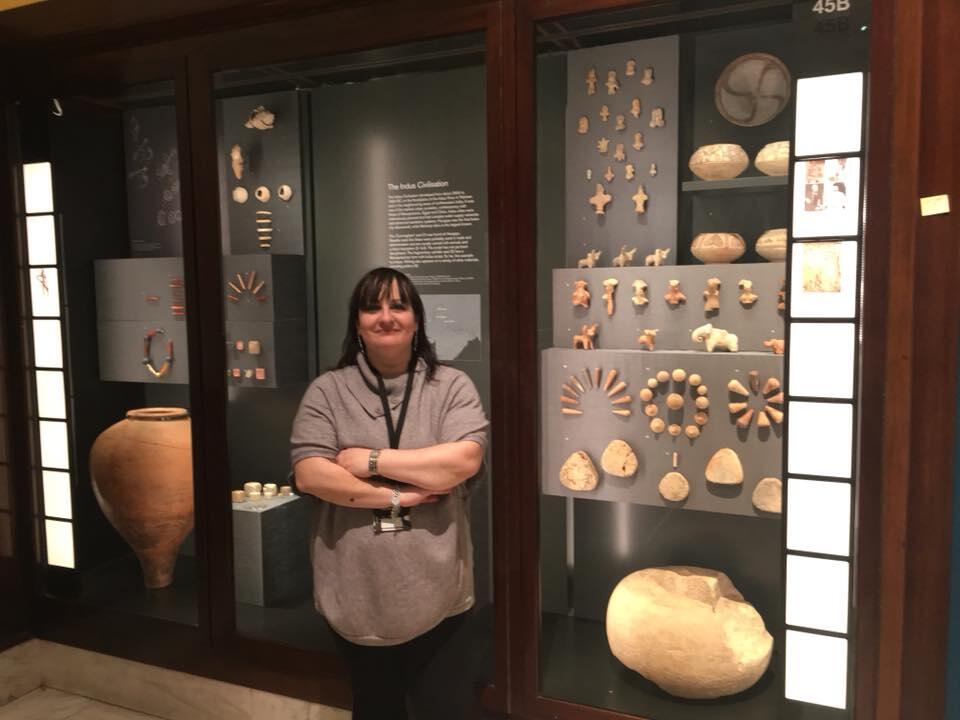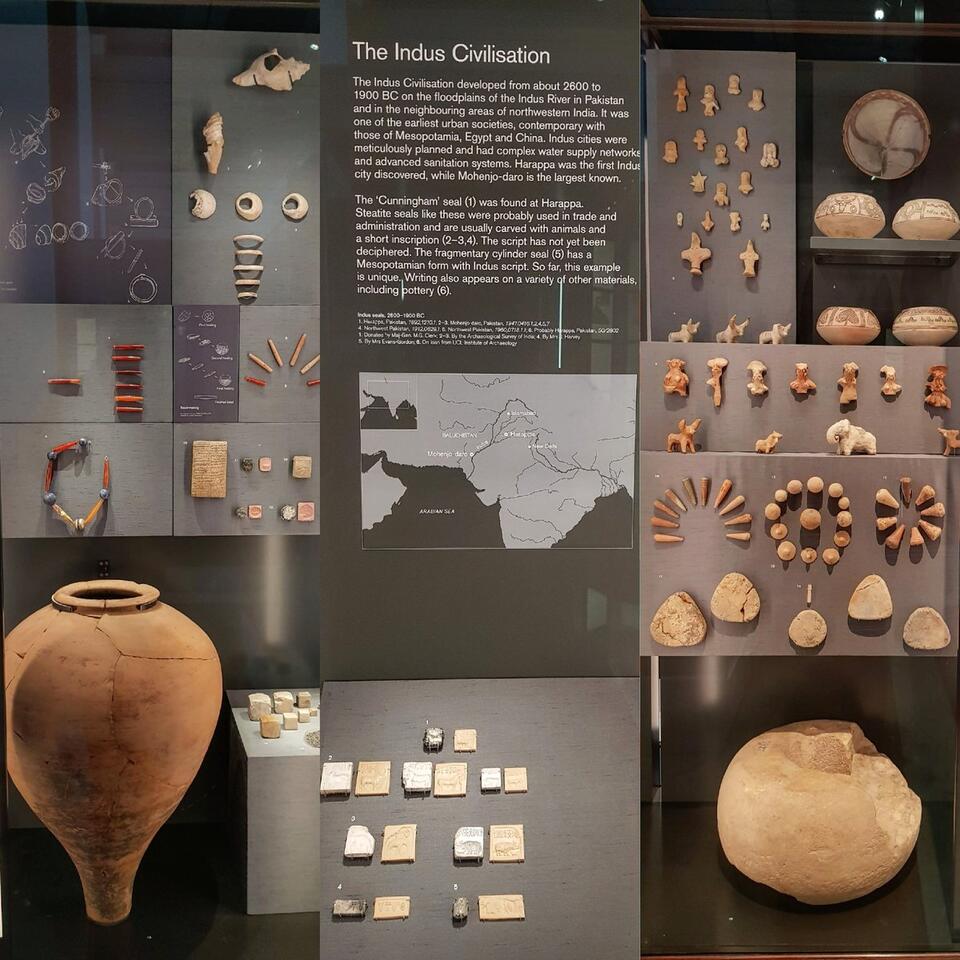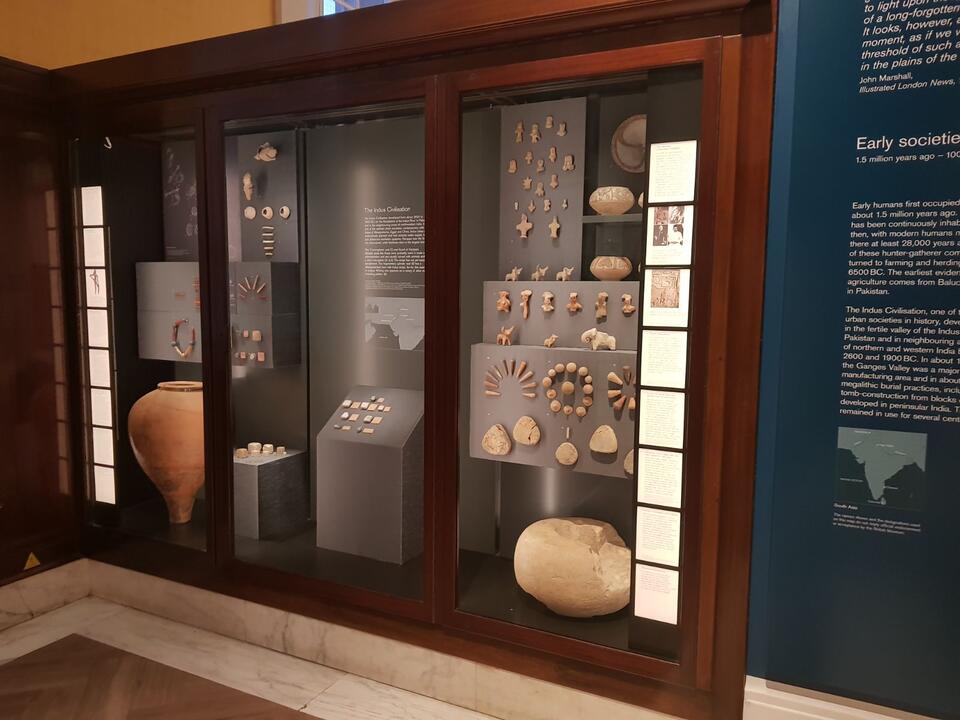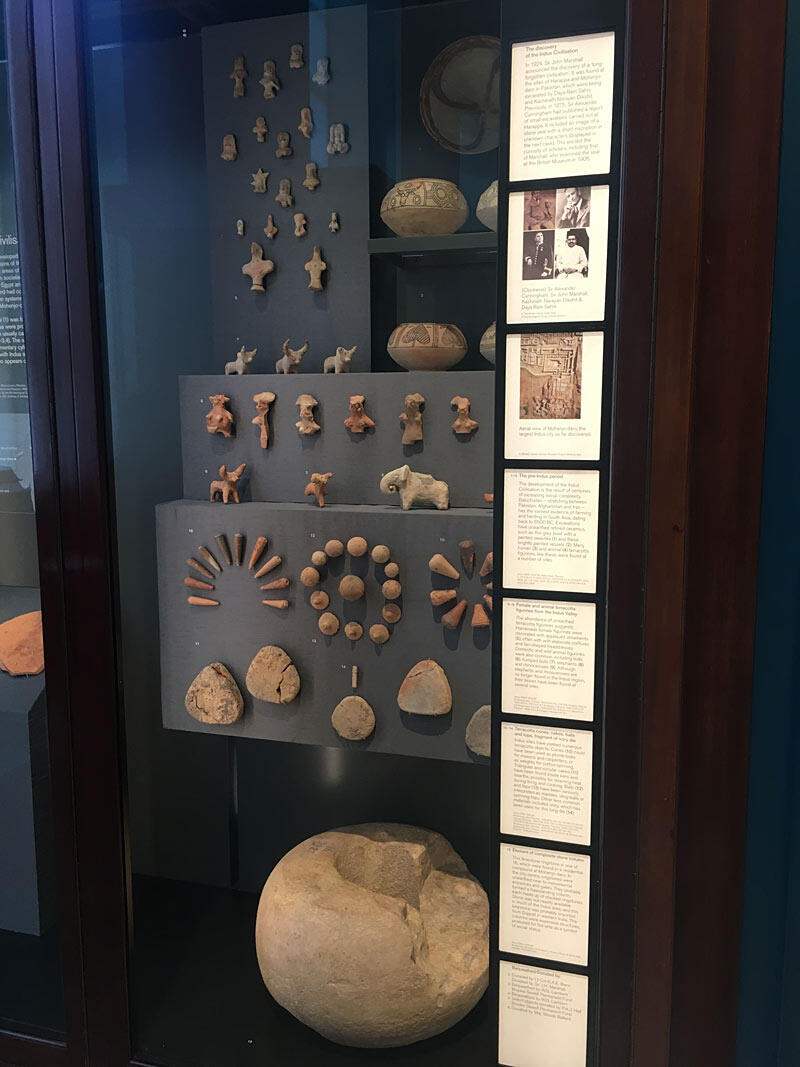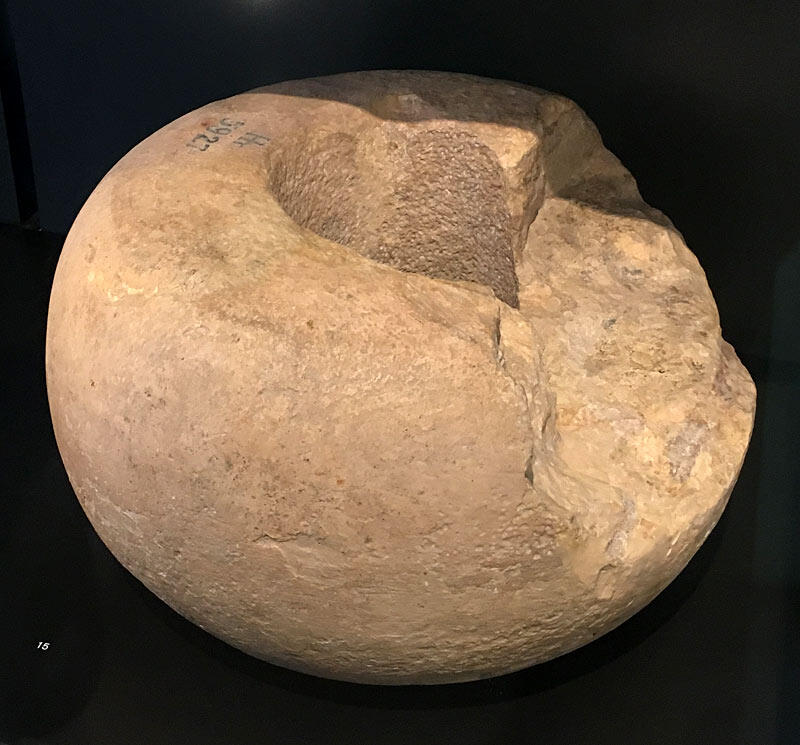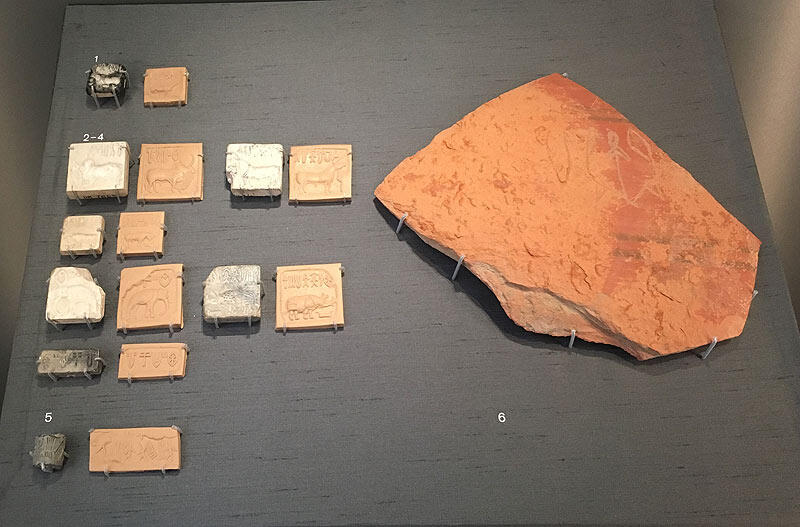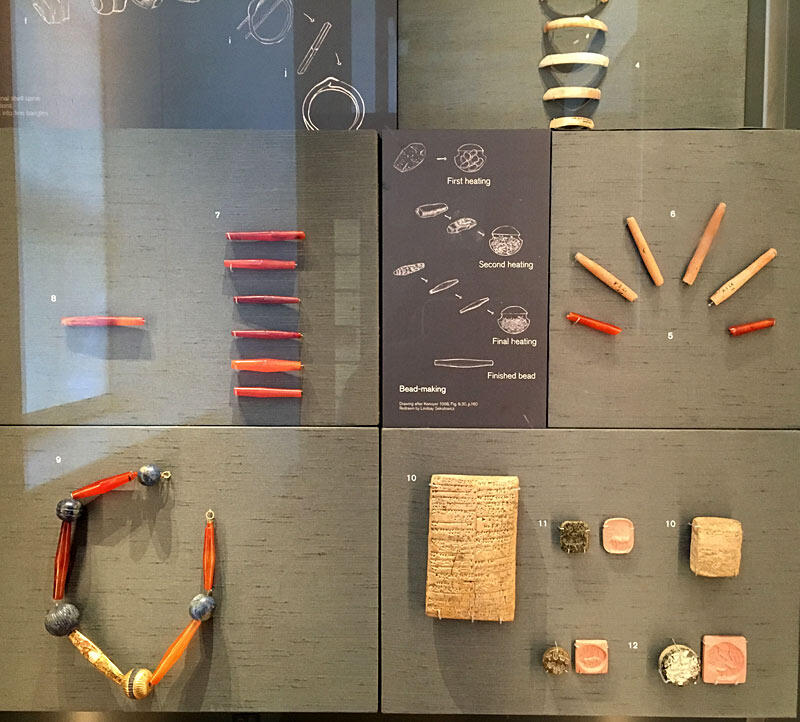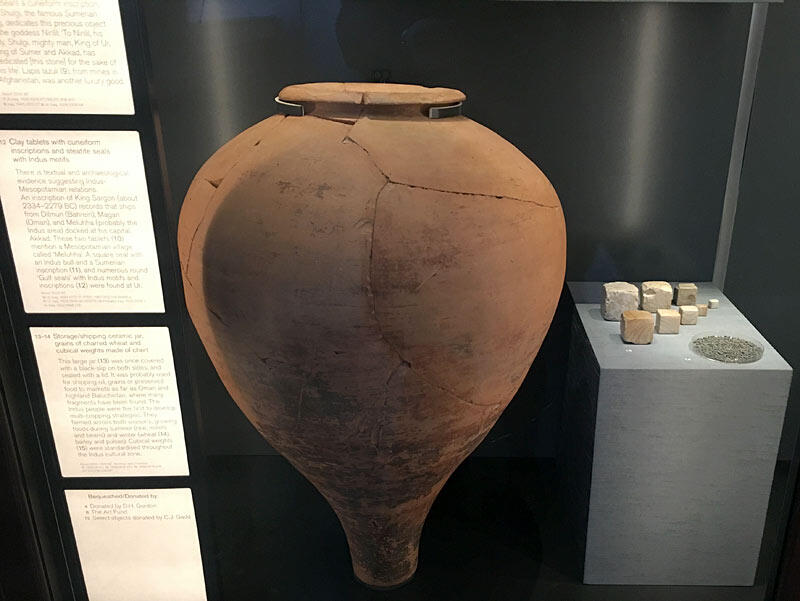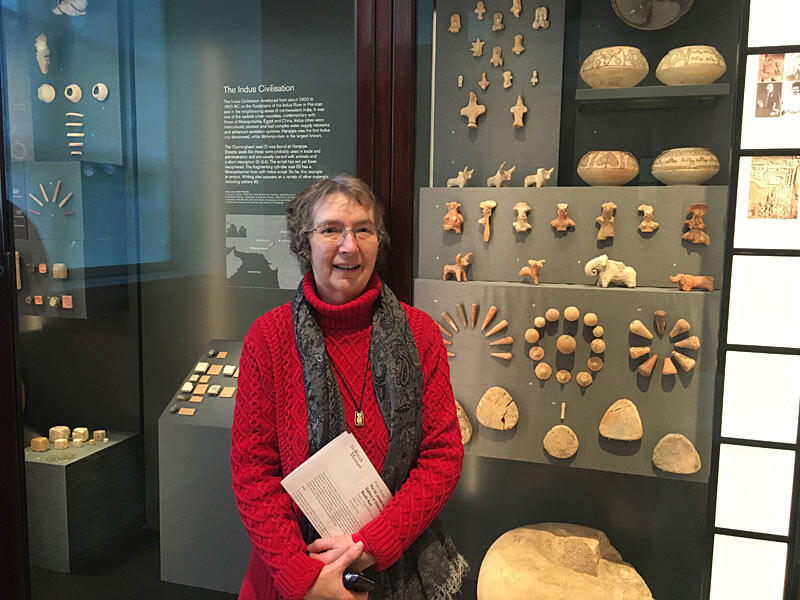December 13th, 2017
Interview with Daniela De Simone, curator of the new Indus display opened at the British Museum on December 15, 2017. The interview with Omar Khan (Harappa.com webmaster) and Ilona Aronovsky (Video editor, Author and Educator) was made in London on July 14, 2017 and embargoed till the opening of the new Hotung Gallery.
Omar: What led to having a new Indus Valley exhibition space at the British Museum, what are the factors and what did you have before?
Daniela: The renovation of the Hotung Gallery offered an opportunity to reconsider our display. Before the renovation, the Indus Civilisation was represented by a small selection of seals and terracotta figurines, and a couple of Nal vessels. We will now have a whole section dedicated to the Indus Civilisation.
Omar: What led to having a new exhibition space?
Daniela: The Hotung Gallery is being renovated after 25 years from its last reorganisation. The new South Asian section is now presented chronologically and with some regional variety. The British Museum holds one of the largest and most complete collections of South Asian material outside South Asia, therefore we decided that the new displays would start with prehistory and end with the contemporary period. The earliest objects we have on display are Palaeolithic handaxes from the Chennai region, which can be dated to c. 1.5 million years ago. The South Asian section concludes with a dramatic ceramic sculpture by Indian artist Mrinalini Mukherjee who passed away in 2015.
The new Indus display will be one of the highlights of the renovated Hotung Gallery. The Indus Civilisation was one of the world’s earliest urban socities, contemporary with those of Mesopotamia, Egypt and China, but it is not as well known as them. The British Museum holds the largest collection of Indus material outside South Asia, a collection that is also historically important as it is made of objects excavated in Mohenjo-daro and Harappa during the very first excavations at the sites.
The Indus Civilisation is included as an optional subject in the English national curriculum. An educational programme for schoolchildren on the Indus Civilisation will be launched in January, we really hope to get more people interested in the subject.
Omar: So, tell us a little bit about your collection, what do you have and what are the highlights of the British museum in this collection?
Daniella: We have material excavated in Mohenjo-daro by Marshall and Mackay, and some objects from Harappa that were donated by the Archaeological Survey of India. One of the most important objects in our collection, as you probably know, is the so-called Cunningham seal. A typical Indus seal bearing an engraved short inscription and the depiction of a ‘unicorn’. It was the first Indus object ever published. While excavating at Harappa in 1872, Alexander Cunningham was shown the seal by Major General Malcolm George Clerk, who acquired it a few years earlier (that is why the seal is also known as the Clerk seal). Cunningham published the seal in 1875 in his excavations report. The short inscription in a then unknown script excited the curiosity of many scholars. Marshall himself came to the BM in 1906 to view the object.
However, what makes our collection special – I think – is the Indus-like material we have from the Middle East, particularly from the excavations at Ur in present-day Iraq. The new Indus display will have a whole section dedicated to Indus-Mesopotamian exchanges.
Omar: Is this the first time they will be displayed?
Daniela: There are some carnelian beads on display in the Mesopotamian gallery.
Omar: I saw those when I was looking around, an amazing amount of Indus stuff.
Daniela: We will show a selection of very interesting objects. One of these is a long, Indus-like carnelian bead with a cuneiform inscription, in which the King Shulgi of Ur is mentioned. Shulgi reigned for about 50 years in c. 2000 BC. This piece of information dates the inscription, but the bead could be earlier. This inscribed bead is a unique object and we are very happy that we are now able to show it to the public. Another interesting object we have on display is a square seal from Ur engraved with a gaur (Indian bison). It bears a cuneiform inscription, not an Indus oneas we would have expected. We also have a cylinder seal from Pakistan, resembling a Mesopotamian cylinder seal, which is inscribed with Indus script. This is another exceptional object in our new display. There is one particular object that I am really excited to have on permanent display, a limestone ringstone – part of a composite column – which was found in a residential compound in Mohenjo-daro (Area HR-B, Block 2, House V, Room 49, North Wall). I think it is interesting for the public to see architectural elements along with seals, figurines, beads etc. It gives a sense of the complexity of the Indus Civilisation.
Omar: How did the inscribed bead come here, it came directly from Marshall, who gave it to the museum?
Daniela: No, the Shulgi bead was acquired by the British Museum in 1945. It was purchased from Charles Alexander Bannerman Carnegie, 11th Earl of Southesk. He acquired the inscribed bead when he was deployed in Iraq with the British Army.
Omar: Can you read the script on the gaur seal?
Daniela: The inscription seems to be a name, but it seems to be neither Sumerian nor Akkadian. Is it an Indus name written with the cuneiform script so that local people could read it? According to Massimo Vidale, the gaur might have represented the community of Indus merchants operating in Mesopotamia. Further research on this seal is being carried out by Massimo Vidale and Dennys Frenez among others and I have been told that the results will be published soon.
Omar: What kind of conservation do you need to do before you present it to the public? Do you have to put chemicals on it?
Daniela: Not much conservation work was needed because the objects are in a very good state of conservation.
Omar: How many of these pieces are being displayed for the first time?
Daniela: Mostly all of them! Only a few Indus seals – including the Cunningham seal – a small number of terracotta figurines, and some cubical weight were on display before the renovation.
Ilona Aronovsky: It was very little, and now it's going to be well worth a class visit for Primary Schools teaching the Indus Civilisation in their history curriculum.
Omar: Do you think there is growing interest in the Indus Civilisation? Why do you think interest in Indus valley is growing?
Daniela: Last year’s Bollywood blockbuster Mohenjo Daro starring Hritik Roshan is probably the sign of growing interest in the Indus Civilisation! In February, the Sindh Governement organised an international conference on the Indus Civilisation in Mohenjo-daro as Pakistan has plans to boost the site as a major tourist attraction. The University of Cambridge has received an ERC grant for its Two Rains project on climate change and the Indus Civilisation. The British Museum will soon have a new Indus display along with an educational programme for schoolchildren. I think things are moving in the right direction!
Omar: Italy has produced a lot of very good Indus scholars. Why?
Daniella: The love affair between South Asia and Italian scholars goes back to the very beginings of Indology. Many missionaries built up a very deep knowledge of the languages, history and art of the subcontinent and Sanskrit was taught at Italian universities by the mid the 19th century, just like anywhere else in Europe. Giuseppe Tucci is known as one of the greatest Tibetologists ever, while the Italian Archaeological Mission to Pakistan has been working in the country since the 1950s. In 1915, Luigi Pio Tessitori, a scholar of Indian bardic literature, was asked by John Marshall to explore sites and monuments in Rajasthan. He discovered the famous Indus site of Kalibangan, which he excavated in 1918.
Omar: How many objects do you think Indus valley objects there are in the whole British museum collection?
Daniela: About 800 objects from Mohenjo-daro and Harappa, a very large number of related potsherds from Baluchistan collected by the late Beatrice De Cardi and a very good collection of Indus-like objects from Iraq and Oman.
Omar: That's a lot.
Daniela: Yes, that's a lot. I think it's the largest collection outside of South Asia
Omar: So there is more stuff to be seen. How many people will see this new exhibition in the course of a year, roughly?
Daniela: More than 7 million people visit the British Museum each year and the Hotung Gallery is one the most visited galleries.
Omar: The South Asian gallery?
Daniela: No, the Hotung Gallery. Its complete name is Sir Joseph Hotung Gallery of China and South Asia.
Omar: Of the visitors who come to the gallery, do you have a sense that are most of them are British or European or Asian?
Daniela: There is a mix of everyone.
Omar: What kind of educational activities do you do now around the Indus valley or you are planning to do?
Daniela: In January 2018, the Learning Department will launch a new virtual visit for school children. Students will learn about the everyday life, technology and trade of the Indus people through examining objects and completing challenges and quizzes in the classroom. More information can be found ">here.
Omar: How did you get into archaeology and into Indian archaeology?
Daniela: I actually wanted to study Indian philosophy! When I was 12, my dad took me to the cinema to watch ‘The Little Buddha’ and I became fascinated by the story of Siddhartha. I started researching Buddhism on encyclopedias and reading about the subject on the books I could find in my hometown - we were in the early 1990s and the internet was not there yet! After high school, I enrolled in a laurea course in Languages and Cultures of South Asia at “L’Orientale”, University of Naples. On the very first day, I attended a class of Art and Archaeology of India and the lecturer was late Prof. Maurizio Taddei, a world-renowned expert in Gandhara art, who was Director of Excavations at important Buddhist sites in Afghanistan and Pakistan. His lectures were so intriguing that I doubted my choice to concentrate on Indian philosophy. However, it was the meeting with Prof. Giovanni Verardi, one of the leading scholars of Buddhist history, art and archaeology that changed everything. At that time, Verardi was lecturer of Art and Archaeology of Central Asia at “L’Orientale” and Director of Excavations at an early Buddhist site near Lumbini, Nepal where the Buddha was born. One day, Verardi asked me whether I was interested in joining his excavations in Nepal. I couldn’t believe it: I was being offered the chance to work where the Buddha walked! I was only 20 when I started working in Nepal (I had visited India and Pakistan the year before), and from that very first day on the site of excavations, Indian archaeology became my career. I am very thankful to Giovanni Verardi for having given me that opportunity.
Omar: What interests you most about archaeology in subcontinent?
Daniela: The complexities of South Asian history are the most exciting things to entangle! In the past, I have mostly worked on Proto-historic and Early Historic archaeology of the Ganges Valley, particularly that of Uttar Pradesh and Bihar. Here at the British Museum, I was given the once in a lifetime opportunity to curate the Prehistoric section, covering a period between 1.5 million years ago to 600 BC, of the new Hotung Gallery, a challenge that I gladly accepted. Laying your hands on the British Museum South Asian Archaeological collections is the dream of every archaeologist interested in South Asia. I have recently started studying a collection of grave goods from South India.
Omar: What in South India in particular are you focusing on?
Daniela: The Nilgiri Hills, a region of upland forests between Tamil Nadu, Karnataka and Kerala. Do you know Ooty?
Omar: I love Ooty.
Daniela: Ooty or Ootacamund (now Udhagamandalam) was the first hill station established by the British, and the summer capital of the Madras Presidency.The British Museum holds the largest collection of grave goods – over 600 objects – excavated from the “megalithic” burials of the Nilgiri Hills by British officials in the 18th century. Smaller collections are stored in Chennai, Berlin and New Delhi.
Omar: In Ooty or in Nilgiri Hills?
Daniella: In and around Ooty, as well as in other areas of the Nilgiri Hills.
Omar: What years does it go back to? What is the period?
Daniela: This is what we're trying to find out. The Nilgiri assemblage is described as ‘Prehistoric’ or as belonging to the ‘South Indian Iron Age’ because the artefacts were unearthed from megalithic tombs. The material reveals interactions and trade exchanges within South Asia and across the Indian Ocean to the Mediterranean and Southeast Asia. I am not able to provide a specific date at the moment, but I am inclined to think that the Nilgiri material dates between the beginning of the first and the first half of the second millennium CE.
Omar: What about the Todas, and how old are they? How old are they?
Daniela: We don't know that. In fact, this new research project wants to leave behind all those questions about who the ‘original’ inhabitants of the Nilgiris are and move towards a comprehensive study of the pre-colonial history of Indian forests and forest-dwellers. Archaeological research in Indian forests is at an early and undeveloped stage. The BM Nilgiri collection offers the unique opportunity to study archaeological material excavated in upland forest areas, which is not only indicative of the complex relations between upland and lowland areas, but it is also revealing of how local forest-dwellers experienced the outside world. The BM Nilgiri material mostly comes from the excavations that J.W. Breeks carried out in the 1860s, but we do also have objects collected by Sir Walter Elliott who, before excavating the famous Buddhist site of Amaravati, worked on the Nilgiri Hills in the 1840s. It’s very exciting!
Omar: How interesting. My friend Christopher Penn – he is thinking of doing something on Breeks –
Daniela: I know him! I met him a few times, he showed me his amazing collection of early photographs from the Nilgiri Hills.
Omar: Any Indus goods, any Indus Valley materials show up in South India?
Daniela: None, as far as I know. However, there are people, for example, who have tried to link the Indus script to megalithic graffiti.
Omar: What about a connection between Megalithic people in South-India and Megalithic people out here in Britain. I went out to see Avebury the other day –
Daniela: We do find megaliths all around the world. And those in India are not really megalithic structures because they are not as big as those you see in Europe, for example, and not as old. I do not see any connection between Stonehenge and Brahmagiri!
Omar: As you have been getting into and learning more about the Indus Valley stuff, what has surprised you the most? What is most unexpected things that have come up against when researching the Indus Valley?
Daniela: There are two aspects of the Indus Civilisation that fascinate me: their political system and their role in the long-distance exchanges across Middle Asia. As we know, archaeologists have found no evidence of a royal palace yet. Did they not have a king? How was the Indus society governed? I think this is really intriguing as it represents a rare scenario in ancient times. As for the long-distance exchange, I wonder what the Indus people were exchanging carnelian beads, lapis lazuli and other goods for.
Omar: Probably wool and other goods, there must have been some exchange of goods.
Daniela: Indus people had cotton, did they really need wool so much?
Omar: Although I think there is a reference to King of Meluhha, so there might have been something.
Daniela: The word king is often used in a broad sense. Siddhartha Guatama is usually referred to as a prince and his father as a king. Suddhodana, however, was just the chief of his clan, the Shakyas.
Omar: Any connections between Buddhism and the Indus valley or do you see it all as speculation?
Daniela: It is all speculation.
Ilona: What's your take about a viewpoint that the Indus Valley had no warfare, that it was very a peaceful place –
Daniela: I don't think so. Bronze weapons have been unearthed at different Indus sites. Greek armies, for example, included a large number of stone throwers and slingers. Perhaps we had a similar scenario in in the Indus region. As far as we know, the terracotta balls that are often found at Indus sites might have been used as weapons.
Ilona: There is a book about the Indus Valley entitled The Peaceful Realms ....
Omar: I don't personally agree with that. Ilona: me neither.
Daniela: I do not agree with that. There are many things about the Indus Civilisation that are just assumptions. Mother Goddesses, for example. Are they goddesses? We do not know anything about their religious beliefs.
Ilona: I think that's what makes it so interesting.
Daniela: Indeed. In Egypt, China, and Mesopotamia, for example, we are used to see royal palaces and religious buildings. In the Indus region there seems to be none of these. Well, we do have the Great Bath but we still do not know what its function really was.
One of the most fascinating things about the Indus Civilisation is its script, don’t you think so? Sometimes I receive emails from people around the world to inform me that they want to give a try to decipher the Indus script. I always wish them good luck and request them to keep me updated on any development. I have not heard back from anyone yet…
Ilona: Even if it was deciphered, you might not get a lot more from the seal inscriptions than names or titles?
Daniela: The Indus script can be deciphered only if a long inscription or the Indus equivalent of a Rosetta stone is found. It is unlikely that these texts would be just names. I doubt the Indus wrote only names. They might have written longer texts on perishable materials such as cloths, for example. However, if an Indus Rosetta stone is to be found, it will be in Mesopotamia, I think. Nothing that gives a clue about the decipherment of the script has ever been found in the Indus region.
Omar: Or the Arabian Gulf.
Daniela: Yes, of course, or the Gulf. However, there have been many excavations of Bronze Age sites in the Indus region, Mesopotamia and the Gulf and no Indus Rosetta stone has surfaced yet. We might never be able to read the Indus script.
Omar: I'm optimistic.
Photographs: Daniela de Simone, Ilona Aronovsky, Alessandro Ceccarelli

